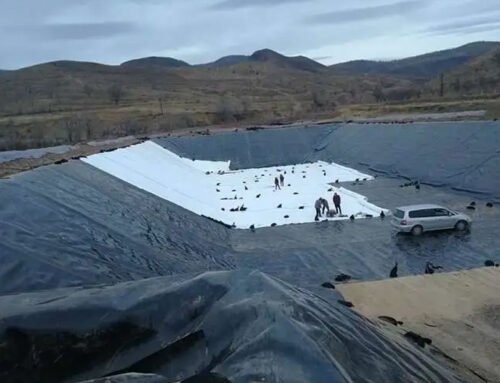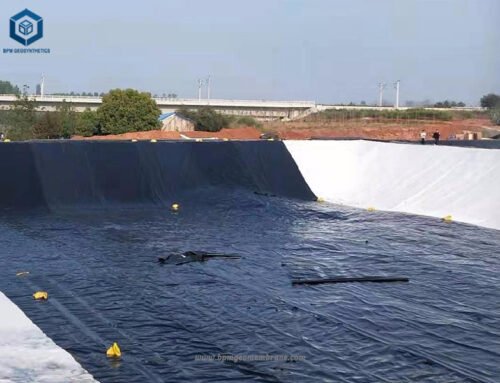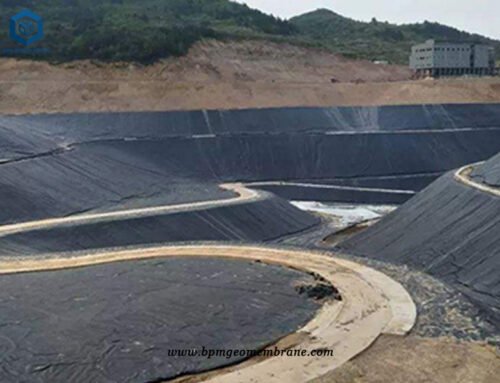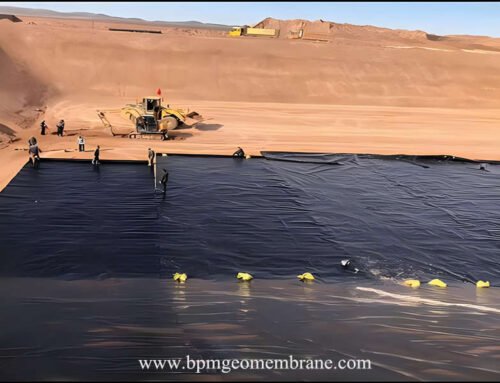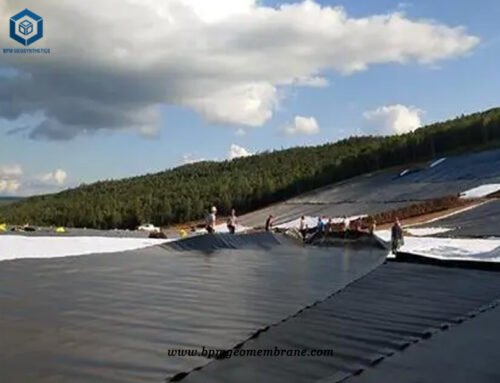HDPE high density polyethylene sheet, also known as high density polyethylene liner or HDPE geomembrane liner, is fabricated by the state-of-the-art automatic geomembrane production lines and advanced three layered pressing technology in accordance with GRI GM13 standard. BPM Geomembrane widely used across a variety of industries including waste containment, water containment, aquaculture, industrial project, energy project and mining project, etc.
1. What Is HDPE High Density Polyethylene Sheet?
HDPE (High Density Polyethylene) sheet is a type of plastic sheeting that is produced from the polymer polyethylene. It is highly regarded for its remarkable strength-to-density ratio, which imparts it with durability and versatility. The utilization of HDPE sheets in various applications is widespread due to their exceptional resistance to chemicals, impact, and moisture.
One of the key advantages of HDPE sheets is their outstanding chemical resistance. They can withstand exposure to a wide range of chemicals, including acids, alkalis, solvents, and oils. This chemical resistance makes HDPE sheets suitable for applications where protection against corrosive substances is essential, such as chemical storage tanks, industrial containers, and pipes.
In addition to chemical resistance, HDPE sheets offer excellent impact resistance. They can withstand heavy impacts without cracking or breaking, making them ideal for applications that require durability and strength, such as protective barriers, cutting boards, and playground equipment. Furthermore, HDPE sheets exhibit exceptional moisture resistance, as they are impermeable to moisture. This quality makes them well-suited for applications involving water or moisture exposure, including water and wastewater treatment systems, agricultural liners, and pond liners.
Overall, HDPE sheets are highly valued for their strength, durability, and versatility, making them a preferred choice in a wide range of industries and applications.
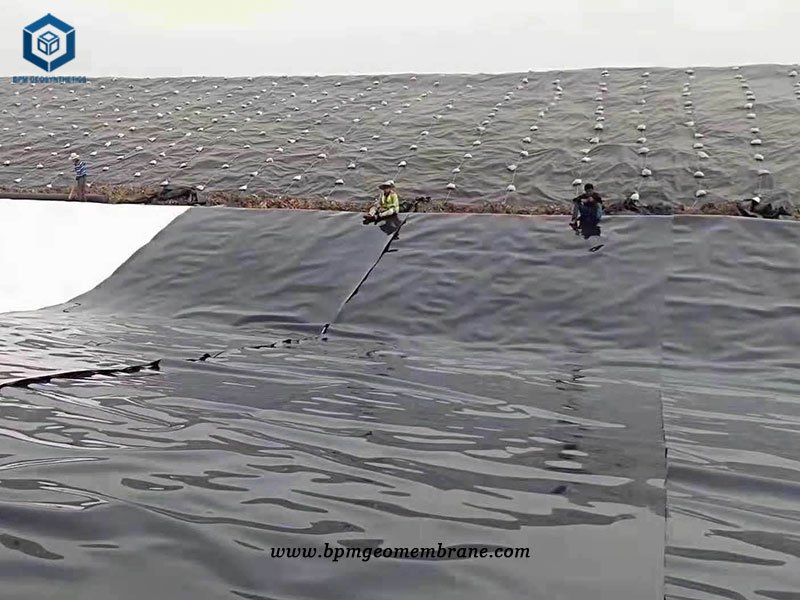
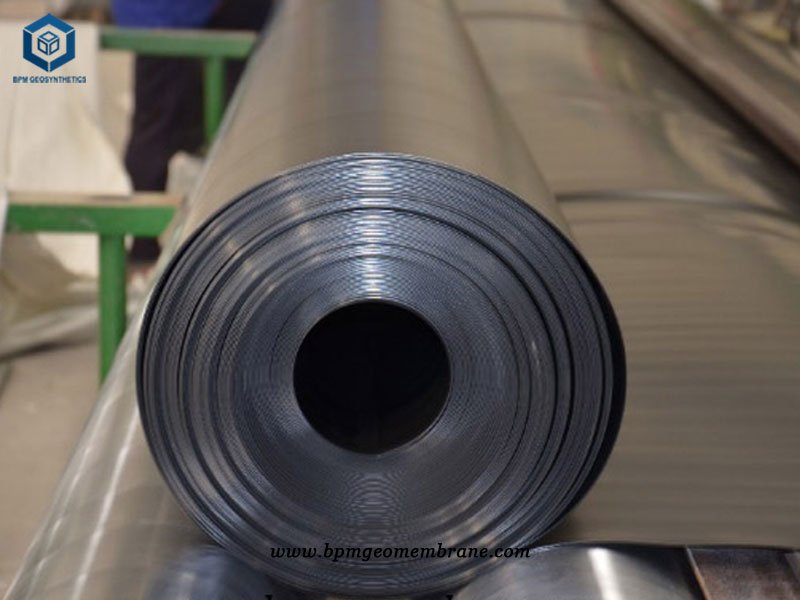
2. What Are Features of HDPE High Density Polyethylene Sheet?
Features of HDPE (High Density Polyethylene) sheet include:
2.1 Excellent Strength-to-Density Ratio
HDPE high density polyethylene sheet possess a remarkable strength-to-density ratio, offering high strength and durability despite being lightweight. This characteristic allows for diverse applications without compromising performance.
2.2 Chemical Resistance
HDPE high density polyethylene sheet exhibit exceptional resistance to various chemicals, such as acids, alkalis, solvents, and oils. This resistance makes them well-suited for environments where exposure to corrosive substances is expected.
2.3 Moisture Resistance
HDPE high density polyethylene sheets are virtually impervious to moisture. They do not absorb water or allow its penetration, ensuring resistance to rot, mold, and mildew. This feature is particularly valuable in applications requiring moisture resistance, including outdoor structures and water containment systems.
2.4 Impact Resistance
HDPE high density polyethylene sheet demonstrate good impact resistance, enabling them to withstand heavy impacts without cracking or breaking. This quality makes them suitable for applications demanding durability and protection against impact, such as protective barriers and impact-resistant surfaces.
2.5 UV Resistance
HDPE high density polyethylene sheets inherently possess UV resistance, enabling them to endure prolonged exposure to sunlight without significant degradation. This attribute is advantageous for outdoor applications necessitating resistance to UV radiation, such as outdoor signage and construction materials.
3.How to Choose HDPE High Density Polyethylene Sheet for Biogas Containment Project?
When selecting HDPE (High Density Polyethylene) sheets for a biogas containment project, it’s important to consider the following:
3.1 Thickness
The appropriate thickness of high-density polyethylene (HDPE) sheets is critical for biogas containment. Factors such as biogas pressure, the size of the containment area, and regulatory requirements should be considered. Thicker sheets are stronger and more resistant to puncture or tearing. Generally, 2mm thick geomembranes are selected.
3.2 Chemical Resistance
HDPE high density polyethylene sheets must exhibit excellent chemical resistance to withstand the corrosive nature of biogas. Ensure that the chosen HDPE material is specifically designed for biogas applications and can withstand the gases and byproducts generated during biogas production.
3.3 Weldability
HDPE high density polyethylene sheets are typically joined using heat fusion techniques like butt welding or extrusion welding. It is essential to choose HDPE sheets that can be easily and securely welded together to ensure proper sealing of the containment system.
3.4 Certification and Compliance
Look for HDPE high density polyethylene sheets that comply with relevant industry standards and certifications. This ensures that the material meets the necessary requirements for biogas containment and provides confidence in its performance and durability.
3.5 Supplier Expertise and Support
Collaborate with a reputable supplier or manufacturer with expertise in biogas containment projects. They can provide guidance on material selection, installation techniques, and ongoing support throughout the project.
3.6 Project-Specific Requirements
Take into account any unique project requirements, such as size, shape, and installation method. Consulting with experts or engineers familiar with biogas containment systems will help ensure that the chosen HDPE sheets align with the specific needs of the project.
4.How to install HDPE High Density Polyethylene Sheet for Biogas Containment Project?
Installing HDPE (High Density Polyethylene) sheets for a biogas containment project requires careful planning and attention to detail. Here are the general steps to follow:
4.1 Site Preparation
Prepare the installation site by ensuring it is level, clean, and compacted. Remove any potential hazards or sharp objects that could damage the HDPE high density polyethylene sheets.
4.2 Measurement and Cutting
Measure the dimensions of the containment area and cut the HDPE high density polyethylene sheets accordingly. Use appropriate tools, such as a utility knife or circular saw, to make precise and clean cuts.
4.3 Seaming/Welding
Join the HDPE high density polyethylene sheets together using heat fusion techniques like butt welding or extrusion welding. Follow the manufacturer’s instructions and utilize specialized equipment to securely and airtightly fuse the sheets.
4.4 Edge Reinforcement
Strengthen the edges of the HDPE high density polyethylene sheets to prevent fraying. This can be done by adding an edge band or heat-welding an HDPE strip along the edges.
4.5 Testing and Inspection
Thoroughly test and inspect the installed HDPE high density polyethylene sheets. Perform leak tests or pressure tests to verify the integrity of the containment system. Carefully examine the seams, edges, and overall installation for any signs of damage.
4.6 Ongoing Monitoring and Maintenance
Regularly monitor the biogas containment system for damage, wear, or gas leakage. Adhere to routine maintenance tasks as recommended by the manufacturer or industry guidelines to ensure the long-term effectiveness of the HDPE high density polyethylene sheets.
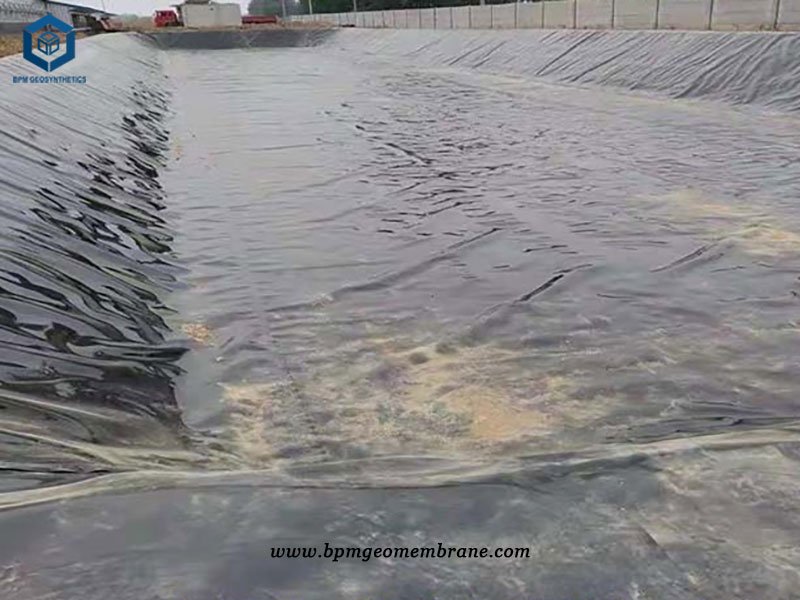

5.Case Study of HDPE High Density Polyethylene Sheet for Biogas Containment Project in New Zealand
At a palm oil plant in New Zealand, a client wanted to use palm oil plant wastewater (POME) to obtain renewable energy while protecting the environment from the harmful effects of methane and biogas emissions. The HDPE high density polyethylene sheet is the ideal geosynthetic material as the anti seepage lining system for biogas containment project.
HDPE high density polyethylene sheet is very effective when used as a floating membrane cover in substrate systems and biogas systems. With their sealing ability, they keep rainwater and other contaminants out, and keep liquids and gases in the pond. By eliminating oxygen, they enhance the activity of anaerobic digestion. They also seal off the smell.
BPM HDPE high density polyethylene sheet is widely used for biogas sealing, and it is selected to line and cover the constructed lagoon. The completed methane capture facility includes a bottom high-quality HDPE geomembrane lining and a high-quality HDPE geomembranes cover.
Our high-quality HDPE geomembrane liner is supported by extensive research and development to meet the needs of the organic waste industry for covered anaerobic lagoons. An on-site immersion test was conducted to monitor the performance and compatibility of the lining in an organic waste environment.
The value of the factory operator is important. The biogas is captured, distributed, processed and used, not only as fuel for two 1,200 kW biogas generator sets, but also as a biogas burner installed on existing biomass boilers. This enables operators to reduce their dependence on fossil fuels and reduce greenhouse gas emissions.
6.Summary
HDPE geomembranes liner is made of polyethylene resin. Additives include carbon black, heat stabilizers and UV stabilizers, and antioxidants. High-quality linings will use raw materials that meet the manufacturer’s standards to provide specific and specified levels of resistance to oxidative degradation, stress cracking and heat resistance, and UV stability. All of these help to extend the life of the material under exposure conditions. The use of light-colored or white geomembranes with the ability to reflect ultraviolet light can provide additional advantages in specific applications.
BPM Geomembrane meets various industry standards and laboratory quality conformance tests, All BPM brand Polyethylene Geomembranes have passed the certificates of the ISO9001, ISO14001, TUV, Soncap, SASO, BV certificates and passed the test of SGS and Intertek etc.
Hope to be your partner.

